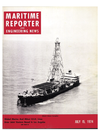
Page 35: of Maritime Reporter Magazine (July 15, 1974)
Read this page in Pdf, Flash or Html5 edition of July 15, 1974 Maritime Reporter Magazine
Maritime Transportation
Research Board Meets
At Webb Institute
The Maritime Transportation
Research Board of the National
Academy of Sciences held its spring meeting at the Webb In- stitute of Naval Architecture in
Glen Cove, N.Y. The board, under the chairmanship of Edgar F.
Luckenbach Jr., president of the
Luckenbach Steamship Company, reviewed its on-going research projects on Nuclear Merchant
Ships, Metrication, Human Error in Merchant Marine Safety, Na- tional Port Requirements and
Sealift Readiness.
In addition to reviewing on- going projects, the board con- sidered new research in the broad areas of maritime trade policies and practices and bulk import capabilities.
In ceremonies held at Webb,
Mr. Luckenbach, retiring this year as chairman of the board, was presented with a certificate of appreciation from the board members by Dr. Ernst Weber, chairman of the National Re- search Council—Division of En- gineering.
The board operates under the
Division of Engineering of the
National Research Council, Na- tional Academy of Sciences, which is chartered by Congress to pro- vide advice to the Government in areas of science and technology.
The board's operations are jointly funded by the Departments of
Transportation, Commerce and
Defense. The chairman and mem- bers of the board serve without compensation in the national in- terest.
The current membership of the board is as follows: Edgar F.
Luckenbach Jr., chairman, presi- dent and chairman of the board,
Luckenbach Steamship Company,
Inc.; Robert J. Abies, attorney at law; Richard B. Couch, Profes- sor, Naval Architecture Research
Office, University of Michigan;
Louis E. Davis, Professor of or- ganizational sciences, director,
Quality of Working Life Pro- gram, Graduate School of Man- agement, University of California at Los Angeles; James A. Fay,
Professor of civil engineering,
Massachusetts Institute of Tech- nology; John T. Gilbride, presi- dent, Todd Shipyards Corp.; John
E. Goldberg, Professor, School of
Civil Engineering, Purdue Uni- versity; Bertram Gottlieb, direc- tor of research, Transportation
Institute; Edwin T. Haefele, di- rector, regional and urban stud- ies, Resources for the Future,
Inc.; John L. Hazard, Professor of Transportation, department of marketing and transportation ad- ministration, Michigan State Uni- versity; James J. Henry, presi- dent, J.J. Henry Co., Inc.; Ran
Hettena, vice president, opera- tions, Maritime Overseas Corpo- ration; David C.G. Kerr, partner,
Macfarlane, Ferguson, Allison &
Kelly; Harold M. Mayer, Univer- sity Professor of Geography, de- partment of geography, Kent
State University; Ben E. Nutter, executive director and chief en- gineer, Port of Oakland; Paul E.
Parfrey, manager, international purchasing and transportation,
AMF, Inc.; Robert J. Pfeiffer, president, Matson Navigation
Company; Richard F. Pollard, senior vice president, The Chase
Manhattan Bank; John B. Ricker
Jr., chairman of the board and president, Marine Office-Appleton & Cox Corp.; Nathan S. Simat, president, Simat, Helliesen &
Eichner, Inc., and Robert T.
Young, president, American Bu- reau of Shipping.
COMSAT GENERAL INTRODUCES
The World's First Maritime Communications Satellite System
Commercial service begins next year
COMSAT GENERAL, a subsidiary of the Communications Satellite Corporation (COMSAT), is the major participant in the establishment of MARISAT, the world's first satellite communications system for use by the international shipping industry.
Small antennas located aboard ships will communicate to shore stations through our maritime satellites to be launched in early 1975. These stations, in turn, will be connected via existing terrestrial or satellite communications facilities to a shipowner's office anywhere in the world.
The M ARISAT system will provide a full range of telex, teletype, data, facsimile, and voice service on a 24-hour per day basis between ships at sea and shore of a quality and reliability not before possible and at reasonable rates.
Scheduling and routing will be improved as continuous contact between a ship at sea
COMSAT GENERAL CORPORATION
M950 L'En/ant Plaza. S W. Washington. DC., U S A 20024 I Telephone 202 5546010 I Telex 89 2343 ••?. Place Isaac Merciei. 1201 Geneva, Switzerland / Telephone 32 61.35 / Telex 045 2-3248
MUenton PO. Box SI Singapore. 11. Republic ot Singapore I Telephone 375 733 / Telex RS 22133 *Suite 2662, 630 Filth Ave . / New York, N. K 10020 I Telephone 212 757 6307 and its shore management will be assured.
The ability to direct ships immediately to new ports to load or off-load cargo will reduce costs and improve shipping management to a degree not now possible.
The MARISAT system will provide fleet owners, for the first time, all the advantages that modern communications techniques have already brought to shore industries
In early 1975, COMSAT
GENERAL'S maritime satellite communications service will be a reality, and shipowners will enjoy the benefits of the world's first satellite communications system designed exclusively for maritime use.
For additional information, write one of the sales offices listed below.
July 15, 1974 35

 34
34

 36
36
